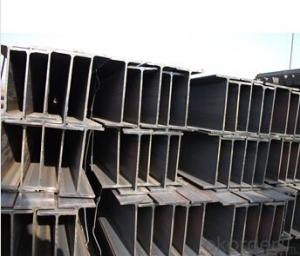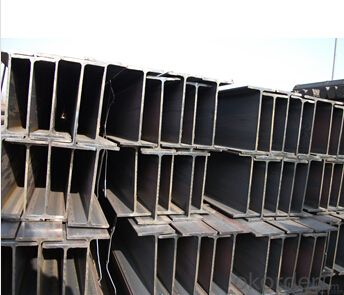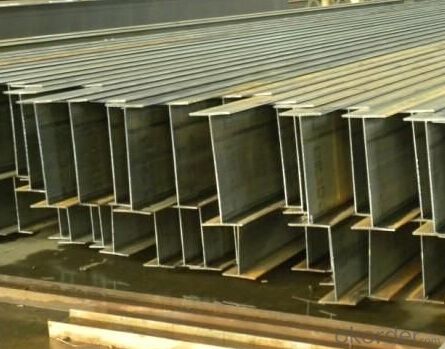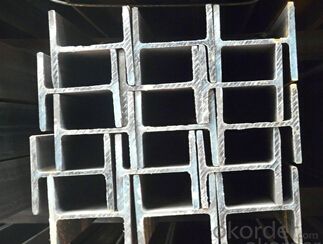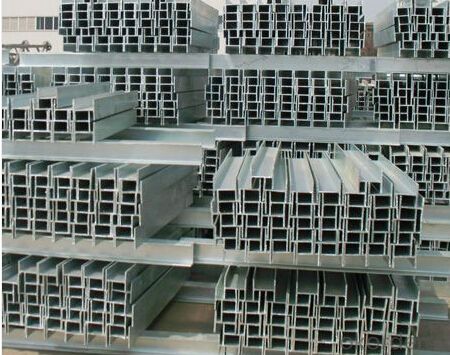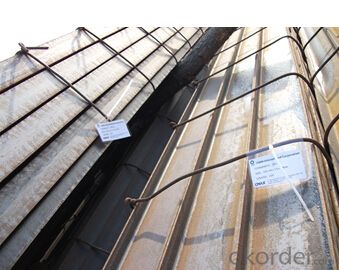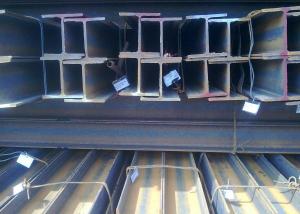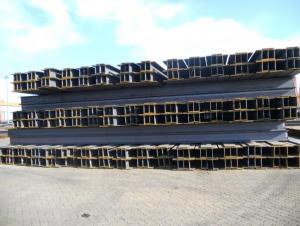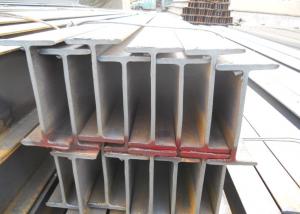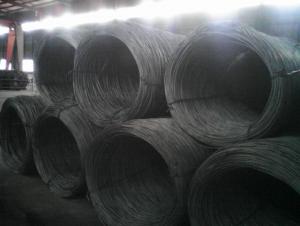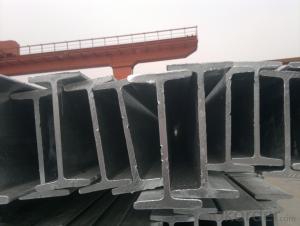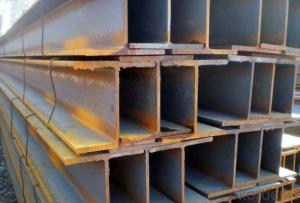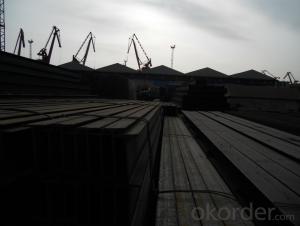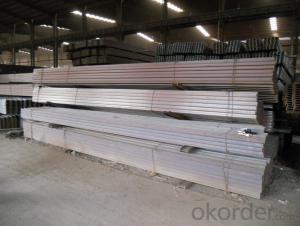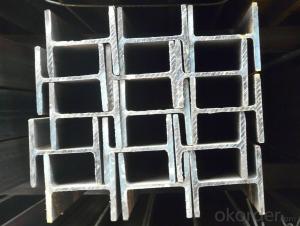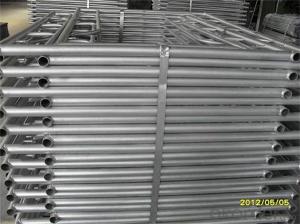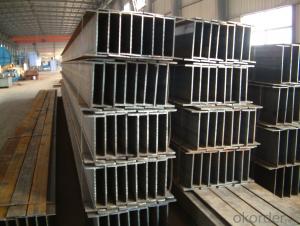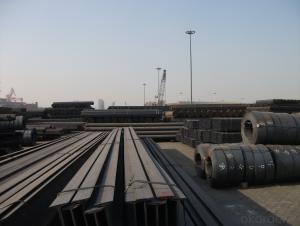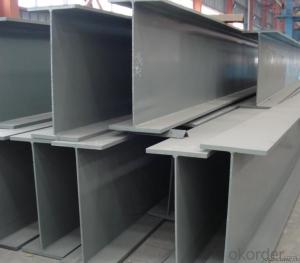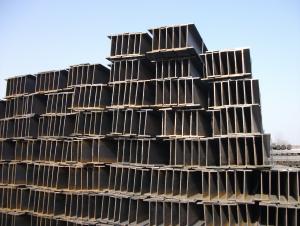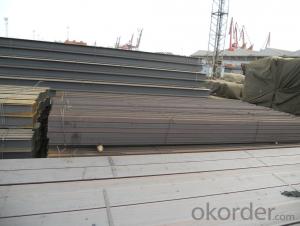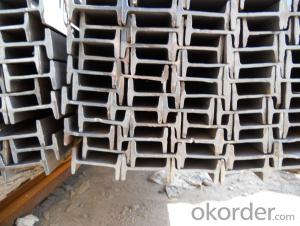GB Q235/Q275 Steel H-Beam
- Loading Port:
- China Main Port
- Payment Terms:
- TT or LC
- Min Order Qty:
- -
- Supply Capability:
- -
OKorder Service Pledge
OKorder Financial Service
You Might Also Like
Product Description:
OKorder is offering GB Q235/Q275 Steel H-Beam at great prices with worldwide shipping. Our supplier is a world-class manufacturer of steel, with our products utilized the world over. OKorder annually supplies products to European, North American and Asian markets. We provide quotations within 24 hours of receiving an inquiry and guarantee competitive prices.
Product Applications:
GB Q235/Q275 Steel H-Beam are ideal for structural applications and are widely used in the construction of buildings and bridges, and the manufacturing, petrochemical, and transportation industries.
Product Advantages:
OKorder's GB Q235/Q275 Steel H-Beam are durable, strong, and resist corrosion.
Main Product Features:
· Premium quality
· Prompt delivery & seaworthy packing (30 days after receiving deposit)
· Corrosion resistance
· Can be recycled and reused
· Mill test certification
· Professional Service
· Competitive pricing
Specifications of Hot Rolled Steel H-beam For Sale:
1. Standard: GB Standard
2. Grade: Q235/Q275
3. Length: 6m/12m
Size:
Size (mm) | Mass (Kg/m) | Size (mm) | Mass (Kg/m) |
150*150*7.0 | 31.1 | 200*100*5.5 | 20.9 |
198*99*4.5 | 17.8 | 194*150*6.0 | 29.9 |
Usage & Applications of Hot Rolled Steel H-beam For Sale
Commercial building structure ;Pre-engineered buildings; Machinery support structure; Prefabricated structure; Medium scale bridges; Ship-building structure.etc.
Production flow of Hot Rolled Steel H-beam For Sale
Material prepare (billet) —heat up—rough rolling—precision rolling—cooling—packing—storage and transportation
*If you would like to get our price, please inform us the size, standard/material and quantity. Thank you very much for your attention.
FAQ:
Q1: Why buy Materials & Equipment from OKorder.com?
A1: All products offered byOKorder.com are carefully selected from China's most reliable manufacturing enterprises. Through its ISO certifications, OKorder.com adheres to the highest standards and a commitment to supply chain safety and customer satisfaction.
Q2: How do we guarantee the quality of our products?
A2: We have established an advanced quality management system which conducts strict quality tests at every step, from raw materials to the final product. At the same time, we provide extensive follow-up service assurances as required.
Q3: How soon can we receive the product after purchase?
A3: Within three days of placing an order, we will begin production. The specific shipping date is dependent upon international and government factors, but is typically 7 to 10 workdays.
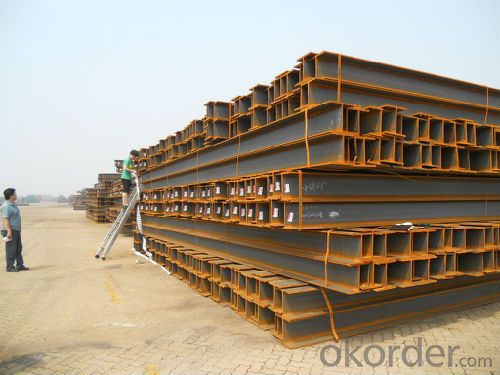
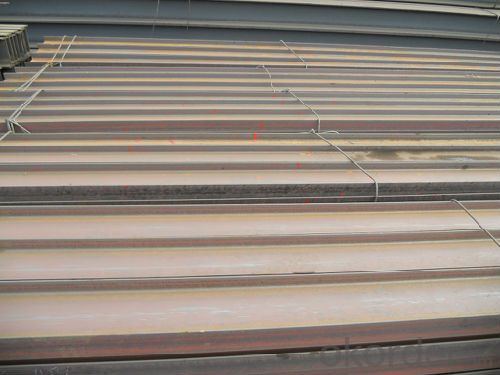
- Q: Are there any limitations or restrictions in using Steel H-Beams in construction?
- Yes, there are certain limitations and restrictions in using Steel H-Beams in construction. Some of these limitations include: 1. Size and weight restrictions: Steel H-Beams come in various sizes and weights, and there may be limitations on the maximum size or weight that can be used in a particular construction project. This is usually determined by the structural engineer who considers factors such as load-bearing capacity, deflection limits, and the overall design requirements. 2. Cost: Steel H-Beams can be more expensive compared to other construction materials such as wood or concrete. This cost factor may restrict their use in budget-constrained projects or where cost optimization is a priority. 3. Availability: Availability of Steel H-Beams may be limited in some regions, especially in remote areas where transportation costs can be prohibitive. This limitation may necessitate the use of alternative materials or different construction methods. 4. Design limitations: Steel H-Beams have specific design requirements that need to be met in order to ensure structural integrity. These include proper connections, bracing, and adequate spacing. Failure to meet these design requirements may lead to a weakened structure or compromised safety. 5. Fire resistance: Steel is not inherently fire-resistant and can lose its strength when exposed to high temperatures. Therefore, additional fire protection measures such as fire-resistant coatings or insulation may need to be considered when using Steel H-Beams in construction, particularly in buildings with specific fire safety regulations. 6. Environmental considerations: Steel production has a significant environmental impact due to the carbon emissions associated with its manufacturing process. In some cases, there may be restrictions or limitations on the use of steel in construction projects that prioritize sustainability or have specific environmental regulations. It is important to consult with a structural engineer and adhere to local building codes and regulations to ensure that the limitations and restrictions of using Steel H-Beams are properly considered and addressed in any construction project.
- Q: What are the common design considerations for steel H-beams in roofing applications?
- To ensure the structural integrity and safety of a roof, it is important to consider various design factors when using steel H-beams in roofing applications. 1. Load-bearing capacity: The steel H-beams must be designed to withstand the weight of the roof and any additional loads, such as snow, wind, or equipment. It is essential to properly size and space the beams to evenly distribute the loads and prevent any potential failure or collapse. 2. Span and support spacing: Careful consideration should be given to determining the span and support spacing of the steel H-beams based on the specific roof design and anticipated loads. Adequate support is necessary to prevent excessive deflection, sagging, or bending. The spacing between the beams should adhere to engineering standards and codes. 3. Connection details: The connections between the steel H-beams and other structural elements, such as columns or purlins, should be meticulously designed and executed. Strong and secure connections are crucial for proper load transfer and to avoid any disconnection or failure. 4. Fire resistance: Steel H-beams used in roofing applications should be designed to provide sufficient fire resistance. This can be achieved through the use of fire-resistant coatings, insulation materials, or the incorporation of fire-rated materials into the design. 5. Corrosion protection: Steel H-beams are susceptible to corrosion, particularly in outdoor roofing applications where they are exposed to the elements. It is necessary to implement appropriate corrosion protection measures, such as galvanizing or using corrosion-resistant coatings, to prolong the lifespan of the beams and maintain their structural integrity. 6. Thermal expansion and contraction: The design of steel H-beams should account for thermal expansion and contraction caused by temperature variations. This can be achieved by incorporating expansion joints or allowing for appropriate clearance and movement in the design. 7. Sustainability considerations: In modern design, sustainability plays a crucial role. Utilizing recycled steel or incorporating energy-efficient design elements can contribute to the overall sustainability of the roofing system. In conclusion, when designing steel H-beams for roofing applications, it is important to consider load-bearing capacity, span and support spacing, connection details, fire resistance, corrosion protection, thermal expansion and contraction, and sustainability. Addressing these design considerations will ensure that the steel H-beams provide a safe and durable roofing solution.
- Q: How do steel H-beams perform in extreme weather conditions?
- Steel H-beams are known for their exceptional strength and durability, which make them suitable for a wide range of applications, including construction and engineering projects. However, it is important to consider how steel H-beams perform in extreme weather conditions. In general, steel is highly resistant to adverse weather conditions such as extreme heat, cold, rain, and wind. H-beams, specifically, are designed to withstand heavy loads and provide structural support, which means they are typically capable of withstanding harsh weather conditions. One key advantage of steel H-beams in extreme weather conditions is their resistance to corrosion. Steel is naturally resistant to rust and deterioration, and proper protective coatings can be applied to enhance its resistance further. This makes steel H-beams a reliable choice even in environments with high humidity or exposure to saltwater. In extreme heat, steel H-beams have a high melting point and can withstand high temperatures without losing their structural integrity. This makes them suitable for areas prone to wildfires or intense heatwaves. Similarly, in cold weather conditions, steel H-beams maintain their strength and stability. They do not become brittle or lose their load-bearing capacity, ensuring the structural integrity of buildings and infrastructure in freezing temperatures. Steel H-beams also fare well in extreme wind conditions. Their sturdy construction and ability to distribute loads effectively make them resistant to strong winds, reducing the risk of structural damage during storms or hurricanes. However, it is essential to note that extreme weather conditions can have various effects on structures, and additional precautions may be necessary depending on the specific circumstances. Factors such as design, quality of materials used, and proper maintenance play crucial roles in ensuring the performance of steel H-beams in extreme weather conditions. Overall, steel H-beams are generally well-suited for extreme weather conditions due to their strength, durability, and resistance to corrosion. Nevertheless, it is always recommended to consult with structural engineers and follow proper guidelines to ensure the safety and longevity of any structure in such conditions.
- Q: Why is it that the steel pile is low in cost and easy to construct, and it can be changed when there is an obstacle
- This is the specification of hot-rolled narrow flange section steel.Cross section 300, flange width 150, web thickness 6.5, flange thickness 9.
- Q: How do steel H-beams perform in extreme weather conditions such as hurricanes or cyclones?
- Steel H-beams are known for their exceptional strength and durability, making them a popular choice for various construction applications, including in areas prone to extreme weather conditions like hurricanes or cyclones. When it comes to withstanding the forces exerted by such weather events, steel H-beams have proven to be highly reliable. The unique structural design of H-beams, with their flanges and web, allows them to distribute loads evenly along their length, making them resistant to bending or buckling. This structural integrity enables H-beams to withstand the strong winds and forces generated by hurricanes or cyclones. In extreme weather conditions, such as hurricanes, the wind speed can reach incredibly high velocities. The aerodynamic design of H-beams, with their streamlined shape and minimal surface area, helps reduce wind resistance. This significantly decreases the chances of the beams being blown away or damaged during the storm. Additionally, steel H-beams have excellent corrosion resistance properties. They are often galvanized or coated with protective coatings, which prevent rust or deterioration caused by moisture, a common occurrence during hurricanes or cyclones. This ensures that the structural integrity of the beams remains intact even after prolonged exposure to extreme weather conditions. Moreover, steel H-beams possess a high load-bearing capacity, allowing them to support heavy loads such as roofs, walls, or floors. This strength is particularly crucial during hurricanes or cyclones, where the beams must withstand not only the wind forces but also the weight of debris or falling objects. Overall, steel H-beams are engineered to perform exceptionally well in extreme weather conditions such as hurricanes or cyclones. Their strength, durability, resistance to bending and buckling, corrosion resistance, and high load-bearing capacity make them a reliable choice for construction in areas prone to such weather events.
- Q: Do steel H-beams require any special maintenance?
- Steel H-beams typically do not require any special maintenance. However, regular inspections and preventive measures can help extend their lifespan and ensure their structural integrity. Some recommended maintenance practices for steel H-beams include: 1. Regular Inspection: Periodic inspections are important to identify any signs of corrosion, deformation, or structural damage. Inspect for cracks, rust, loose connections, or any other signs of wear and tear. Promptly address any issues to prevent further damage. 2. Cleaning: Keeping the beams clean by removing dirt, debris, and other contaminants helps prevent corrosion and deterioration. Regular cleaning with a mild detergent and water can help maintain their appearance and durability. 3. Rust Prevention: Applying a rust-resistant coating or paint to the beams can prevent corrosion. Be sure to use a high-quality coating that is specifically designed for steel structures and follow the manufacturer's instructions for proper application. 4. Vibration and Movement: H-beams may be subjected to vibrations or movement due to various factors such as heavy machinery or seismic activities. Regularly check for any signs of excessive movement or vibration and address them promptly to prevent further damage. 5. Proper Load Distribution: Ensure that the load on the H-beams is properly distributed to avoid overloading or excessive stress. Consult with a structural engineer to determine the appropriate load capacity and ensure that it is not exceeded. Overall, while steel H-beams are durable and require minimal maintenance, regular inspections and preventive measures can help ensure their long-term performance and safety. It is always recommended to consult with a professional engineer or contractor for specific maintenance requirements based on the project and environmental conditions.
- Q: Are steel H-beams resistant to termites?
- Yes, steel H-beams are highly resistant to termites.
- Q: How do steel H-beams compare to timber beams in terms of sustainability?
- Steel H-beams and timber beams differ significantly in terms of sustainability. Steel H-beams are typically made from recycled steel, which reduces the demand for new steel production and minimizes the carbon footprint associated with manufacturing. Additionally, steel is a highly durable material, meaning that steel H-beams have a longer lifespan and require fewer replacements over time. This durability results in less waste generation and lower maintenance costs, making steel H-beams a more sustainable option in the long run. On the other hand, timber beams have their own sustainability advantages. Timber is a renewable resource, as trees can be replanted to replace those that are harvested. The production of timber beams also requires less energy compared to steel H-beams. Furthermore, the process of harvesting and manufacturing timber has a lower carbon footprint compared to steel production, as it produces fewer greenhouse gas emissions. However, timber beams have limitations in terms of durability and resistance to fire and moisture. They are prone to decay, insect damage, and warping, which can decrease their lifespan and increase maintenance and replacement needs. Additionally, the use of timber from unsustainable logging practices can contribute to deforestation and habitat destruction. In summary, while both steel H-beams and timber beams have sustainability benefits, steel H-beams have the advantage of being made from recycled materials, offering high durability, and reducing waste generation. Timber beams, on the other hand, are renewable, require less energy in production, and have a lower carbon footprint. Ultimately, the choice between steel H-beams and timber beams should consider factors such as the specific application, local availability of materials, and the overall environmental impact throughout the life cycle of the beams.
- Q: Are steel H-beams resistant to ultraviolet (UV) radiation?
- Steel H-beams are not inherently resistant to ultraviolet (UV) radiation. UV radiation from the sun can cause degradation and discoloration of steel surfaces over time. However, the extent of this degradation depends on various factors such as the specific type of steel used and the duration and intensity of UV exposure. To mitigate the effects of UV radiation on steel H-beams, protective coatings can be applied. These coatings act as a barrier, shielding the steel from direct exposure to UV rays. Common protective coatings for steel include paint, powder coating, and galvanizing. Paint coatings provide a layer of protection against UV radiation, but they may require periodic maintenance and reapplication to ensure continued effectiveness. Powder coating, on the other hand, offers greater durability and resistance to UV radiation. Galvanizing is another option, where steel H-beams are coated with a layer of zinc to provide protection against UV radiation and corrosion. It is important to note that even with protective coatings, the long-term durability of steel H-beams under UV exposure will depend on factors such as the quality of the coating, the environment in which they are installed, and maintenance practices. Regular inspection and maintenance can help identify any signs of degradation or damage and allow for timely repairs or reapplication of protective coatings if necessary. In summary, while steel H-beams are not inherently resistant to UV radiation, the use of protective coatings can significantly enhance their resistance to UV degradation and extend their lifespan.
- Q: Can steel H-beams be used for sports arenas or stadiums?
- Yes, steel H-beams can be used for sports arenas or stadiums. They are commonly used in the construction of large-scale structures due to their high strength, durability, and load-bearing capacity. The H-beam's design allows for efficient structural support, making it suitable for withstanding the heavy loads and stresses experienced in sports arenas or stadiums.
Send your message to us
GB Q235/Q275 Steel H-Beam
- Loading Port:
- China Main Port
- Payment Terms:
- TT or LC
- Min Order Qty:
- -
- Supply Capability:
- -
OKorder Service Pledge
OKorder Financial Service
Similar products
Hot products
Hot Searches
Related keywords
